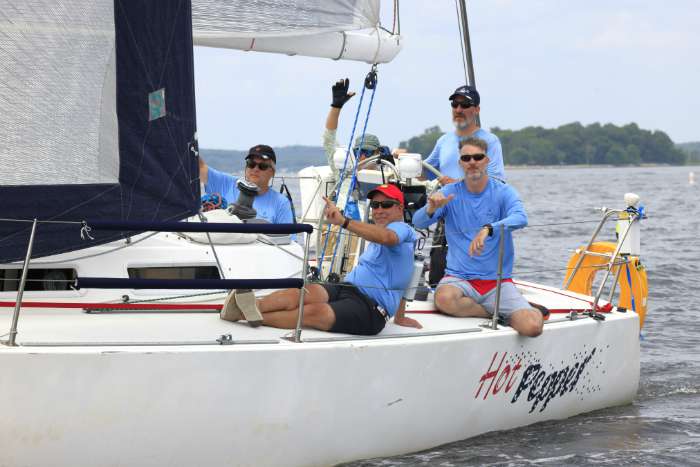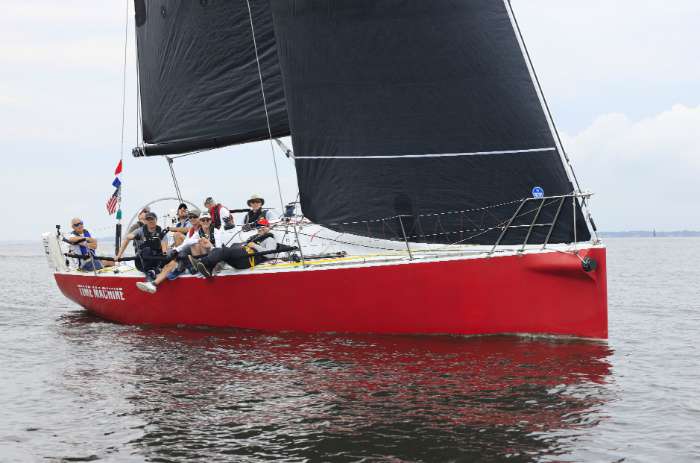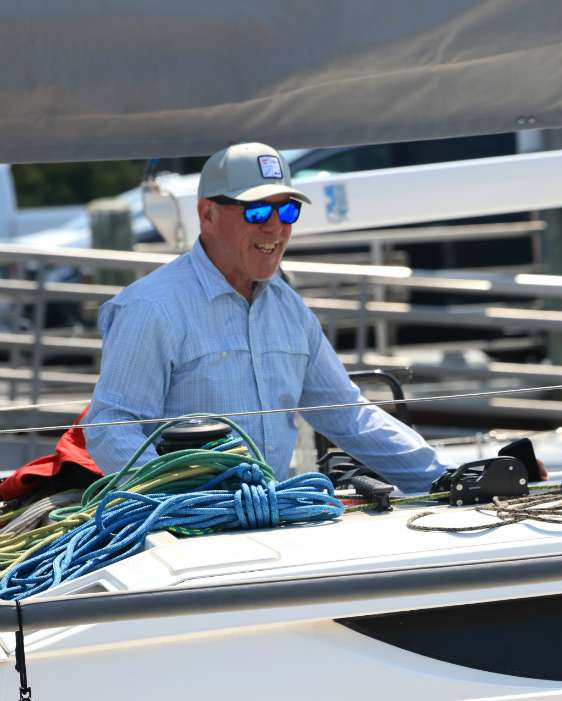Experienced Chesapeake Skippers Racing Offshore for the First Time Share Their Journeys
It didn’t go as expected… and “yes,” they will do it again. That was the overarching theme when we interviewed first-time offshore racing skippers after the 2025 Annapolis to Newport Race (A2N), a 475-mile distance race from Annapolis to Newport, hosted by Annapolis YC June 6-11.

Challenges faced
Steven Toole, skipper of the J/120 Hot Pepper hadn’t been offshore for many years.
“Our biggest challenge by far was preparing Hot Pepper and our crew to go from Bay racing to ocean racing. The amount of equipment, additional sails, and gear required was far more than I expected,” he said.
“While most of our crew had done at least one ocean race in the past, many were new to ocean racing or hadn't raced offshore in many years. But ultimately, I feel that we're now better (and safer) Bay racers because of all the prep work for A2N, and Hot Pepper is in better shape than she's been in a long time. The most damage Hot Pepper incurred during the A2N was a broken paper towel rack in the galley, so I'd say our preparation served us well.”
The A2N was Bruce Irvin’s first-ever offshore race. He and his team competed aboard his Corby 40 Time Machine. He echoes Toole’s sentiments: “The top challenge was getting the boat ready for offshore racing. All new instrumentation and wiring were added this year, along with a navigation station and water tank. Adjusting to a watch system was new for our team, and sleep deprivation definitely came into play over three and a half days. The last big challenge was getting out of the Bay with a very light southerly breeze.”
Irvin did face one daunting challenge: “We had one very large surprise at 02:50 on Monday morning (June 9). In very dense fog, we ran into, presumably, a deepwater fishing net tandem buoy rig in 300 feet of water approximately 50 miles off of Long Island. We split the two unlighted buoys, which were attached together with line, with the larger eight-foot-tall buoy attached to something near or on the bottom. It proved to be a very effective Venus fly trap for boats with a bulb keel, with each buoy coming to rest on opposite sides of the boat; the spinnaker collapsed and the boat auto-tacked, wrapping both lines around the keel.

“With an unknown object now firmly attached to the boat, I chose to radio the Coast Guard for guidance on what the object could be and to let them know of our intention to cut the main line to free the boat. We received excellent assistance from Patrick Hylant's crew on Moxie, who jumped in to relay the fractured coms between us and the USCG. It was great to have a fellow competitor render that aid in the middle of the night. The Coast Guard had no detail on what the rig was and approved cutting it loose. Once freed, we raised the sails and got back to racing.”
When asked if he faced any surprises, Toole says that his happened before the race: “Yacht racing is an expensive pursuit, so I shouldn't be surprised. But the costs to prepare the boat, gear, sails, and crew far exceeded my expectations when I signed up for the race. Thankfully, the racing community really exhibited an amazing showing of support and collaboration. Jon Opert of Orion was kind enough to lend me his life raft, EPIRB, drogue, and Danbuoy. Skippers from other J/120—Richard Borne of Windborn, and John Sartorious from Alibi—both donated decommissioned sails for us to use since we blew out our spinnaker in the Miles River Race just two weeks before the A2N. Of note, Alibi was a direct competitor of Hot Pepper within the A2N PHRF fleet and yet still graciously gave us their old sail for us to use against them in A2N (they beat us anyway LOL).”
And next time?
We asked both skippers if they could do the race over again what they’d have done differently. Toole says, “Personally, I'd like to improve my weather routing knowledge, experience, and capabilities. We did have an excellent tactician onboard who provided lots of good guidance on weather routing, strategy and tactics. Where I personally fell short was really understanding the context of that advice amidst the maps and weather prediction models we had onboard. I would also like to upgrade our satellite communication.”
Irvin adds, “I am not sure I would do any of the big things differently. In all the months of prep, I did forget to bring a water bottle; I would definitely bring one. And, maybe cut lines first.”
Toole, whose team finished eighth in PHRF, says he’d absolutely do this race again: “It was an amazing adventure, and we're better racers for it. I would also hate to think that I made such a huge investment in offshore racing for just one race, so I plan to put all of that to good use in future offshore races on Hot Pepper.”
Irvin, whose team finished ninth in ORC Open 3, says, “We will definitely do the 2027 A2N Race and are already looking forward to the Annapolis to Bermuda Race next year. It was a large preparation hill to climb, and it felt great to achieve a long-standing racing goal. Under a full moon at 03:00 Wednesday morning, I will never forget hearing the RC announce our finish time and say, ‘Welcome to Newport.’”

An excellent adventure anyway
Tony Moynagh, skipper of his Beneteau 10R Elvis, and his teammate in the Doublehanded Division, Tom Pfeifer, made the heartbreaker decision of retiring from the race. The duo had raced together in Chicago Mac Races on Pfeifer’s Dickerson 37 Joysea and also competed in the second Doublehanded Distance Race on the Chesapeake as a team.
Moynagh says, “The reason for our retirement from this year's A2N was that we simply ran out of days. After a Friday start, we left the Bay 36 hours later and headed north in a rinse/repeat cycle of fair breeze followed by none at all. We found ourselves bobbing aimlessly once again early in the morning on Tuesday with a dismal forecast which our simple math told us meant at least another 24 to 36 hours before we might finish. So, at that point we made the decision to head to Newport under power.”
Many experienced teams were forced to make the same decision due to light air and time constraints.
“In spite of the disappointment that came with our choice to retire, we had an excellent time,” says Moynagh. “Our Beneteau 10R Elvis performed beautifully in her first trip offshore. Tom and I couldn't have gotten along better during the days we spent out there. The race organizers had the red carpet out in Newport, and we had a great time up there as well. That was followed by the delivery back to Annapolis.... slightly bittersweet in that the conditions meant for champagne sailing the entire trip (to the weather gods: ‘Where were you when I needed you?’).”
Thanks to these skippers for providing valuable feedback for racing sailors considering a first offshore race. If such a challenge is on your mind for 2026, note that the Mustang Survival Annapolis Bermuda Ocean Race has created a mentorship program for new ocean racers—in addition to its well-known series of informational happy hours and seminars. Reach out to organizers to learn more.
We have a trove of offshore sailing tips right here at spinsheet.com.




